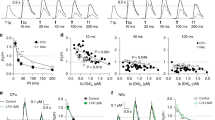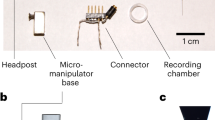Abstract
Despite the importance of dopamine signaling, it remains unknown if the two major subclasses of dopamine receptors exist on the same or distinct populations of neurons. Here we used confocal microscopy to demonstrate that virtually all striatal neurons, both in vitro and in vivo, contained dopamine receptors of both classes. We also provide functional evidence for such colocalization: in essentially all neurons examined, fenoldopam, an agonist of the D1 subclass of receptors, inhibited both the Na+/K+ pump and tetrodotoxin (TTX)-sensitive sodium channels, and quinpirole, an agonist of the D2 subclass of receptors, activated TTX-sensitive sodium channels. Thus D1 and D2 classes of ligands may functionally interact in virtually all dopamine-responsive neurons within the basal ganglia.
This is a preview of subscription content, access via your institution
Access options
Subscribe to this journal
Receive 12 print issues and online access
$209.00 per year
only $17.42 per issue
Buy this article
- Purchase on Springer Link
- Instant access to full article PDF
Prices may be subject to local taxes which are calculated during checkout





Similar content being viewed by others
References
Missale, C., Nash, S. R., Robinson, S. W., Jaber, M. & Caron, M. G. Dopamine receptors: from structure to function. Physiol. Rev. 78, 189–225 (1998).
Chase, T. N., Oh, J. D. & Blanchet, P. J. Neostriatal mechanisms in Parkinson's disease. Neurology 51, S30–35 (1998).
Grace, A. A., Gerfen, C. R. & Aston-Jones G. Catecholamines in central neurvous system. Overview. Adv. Pharmacol. 42,655–670 (1998).
Knable, M. B. & Weinberger, D. R. Dopamine, the prefrontal cortex and schizophrenia. J. Psychopharmacol. 11, 123–131 (1997).
Egan, M. F. & Weinberger, D. R. Neurobiology of schizophrenia. Curr. Opin. Neurobiol. 7, 701–707 (1997).
Castellanos, F. X. Toward a pathophysiology of attention-deficit/hyperactivity disorder. Clin. Pediatr. (Phila.) 36, 381–393 (1997).
Swanson, J., Castellanos, F. X., Murias, M., LaHoste, G. & Kennedy J. Cognitive neuroscience of attention deficit hyperactivity disorder and hyperkinetic disorder. Curr. Opin. Neurobiol. 8, 263–271 (1998).
Self, D. W., Barnhart, W. J., Lehman, D. A. & Nestler, E. J. Opposite modulation of cocaine-seeking behavior by D1- and D2-like dopamine receptor agonists. Science 27, 1586–1589 (1996).
Koob, G. F. & Le Moal, M. Drug abuse: hedonic homeostatic dysregulation. Science 278, 52–58 (1997).
Gerfen, C. R. & Keefe, K. A. Neostriatal dopamine receptors. Trends Neurosci. 17, 2–3 (1994).
Bloch, B. & Le Moine, C. Neostriatal dopamine receptors. Trends Neurosci. 17, 3–4 (1994).
Surmeier, D. J., Reiner, A., Levine, M. S. & Ariano, M. A. Neostriatal dopamine receptors. Trends Neurosci. 17, 4–5 (1994).
Surmeier, D. J., Reiner, A., Levine, M. S. & Ariano, M. A. Are neostriatal dopamine receptors co-localized? Trends Neurosci. 16, 299–305 (1993).
Gerfen, C. R. The neostriatal mosaic: multiple levels of compartmental organization. Trends Neurosci. 15, 133–139 (1992).
Le Moine, C. & Bloch, B. D1 and D2 dopamine receptor gene expression in the rat striatum: sensitive cRNA probes demonstrate prominent segregation of D1 and D2 mRNAs in distinct neuronal populations of the dorsal and ventral striatum. J. Comp. Neurol. 355, 418–426 (1995).
Gerfen, C. R. et al. D1 and D2 dopamine receptor-regulated gene expression of striatonigral and striatopallidal neurons. Science 250, 1429–1432 (1990).
Yung, K. K. et al. Immunocytochemical localization of D1 and D2 dopamine receptors in the basal ganglia of the rat: light and electron microscopy. Neuroscience 65, 709–730 (1995).
Surmeier, D. J. et al. Dopamine receptor subtypes colocalize in rat striatonigral neurons. Proc. Natl. Acad. Sci. USA 89, 10178–10182 (1992).
Ouimet, C. C. & Greengard, P. Distribution of DARPP-32 in the basal ganglia: an electron microscopic study. J. Neurocytol. 19, 39–52 (1990).
Anderson, K. D. & Reiner, A. Immunohistochemical localization of DARPP-32 in striatal projection neurons and striatal interneurons: implications for the localization of D1-like dopamine receptors on different types of striatal neurons. Brain Res. 568, 235–243 (1991).
Borin, M. L. Dual inhibitory effects of dopamine on Na+ homeostasis in rat aorta smooth muscle cells. Am. J. Physiol. 272, C428–438 (1997).
Cepeda, C., Buchwald, N. A. & Levine, M. S. Neuromodulatory actions of dopamine in the neostriatum are dependent upon the excitatory amino acid receptor subtypes activated. Proc. Natl. Acad. Sci. USA 90, 9576–9580 (1993).
Levey, A. I. et al. Localization of D1 and D2 dopamine receptors in brain with subtype-specific antibodies. Proc. Natl. Acad. Sci. USA 90, 8861–8865 (1993).
Le Moine, C., Normand, E. & Bloch, B. Phenotypical characterization of the rat striatal neurons expressing the D1 dopamine receptor gene. Proc. Natl. Acad. Sci. USA 88, 4205–4209 (1991).
Surmeier, D. J., Song, W. J. & Yan, Z. Coordinated expression of dopamine receptors in neostriatal medium spiny neurons. J. Neurosci. 16, 6579–6591 (1996).
Belusa, R. et al. Mutation of the protein kinase C phosphorylation site on rat alpha1 Na+,K+-ATPase alters regulation of intracellular Na+ and pH and influences cell shape and adhesiveness. J. Biol. Chem. 272, 20179–20184 (1997).
Borin, M. L., Goldman, W. F. & Blaustein, M. P. Intracellular free Na+ in resting and activated A7r5 vascular smooth muscle cells. Am. J. Physiol. 264, C1513–1524 (1993).
Satoh, H. et al. Regulation of [Na+]i and [Ca2+]i in guinea pig myocytes: dual loading of fluorescent indicators SBFI and fluo 3. Am. J. Physiol. 266, H568–576 (1994).
Peng, L., Martin-Vasallo, P. & Sweadner, K. J. Isoforms of Na,K-ATPase alpha and beta subunits in the rat cerebellum and in granule cell cultures. J. Neurosci. 17, 3488–3502 (1997).
Pietrini, G., Matteoli, M., Banker, G. & Caplan M. J. Isoforms of the Na,K-ATPase are present in both axons and dendrites of hippocampal neurons in culture. Proc. Natl. Acad. Sci. USA 89, 8414–8418 (1992).
Jewell, E. A. & Lingrel, J. Comparison of the substrate dependence properties of the rat Na,K-ATPase alpha1, alpha 2 and alpha 3 isoforms expressed in HeLa cells. J. Biol. Chem. 266, 16925–16930 (1991).
Zahler, R., Zhang, Z.-T, Manor, M. & Boron, W. F. Sodium kinetics of Na,K-ATPase α isoforms in intact transfected HeLa cells. J. Gen. Physiol. 110, 201–213 (1997).
Johnson, S. W., Seutin, V. & North, R. A. Burst firing in dopamine neurons induced by N-methyl-d-aspartate: role of electrogenic sodium pump. Science 258, 665–667 (1992).
Yu, X. M. & Salter, M. W. Gain control of NMDA-receptor currents by intracellular sodium. Nature 396, 469–474 (1998).
Bockaert, J. et al. Primary culture of striatal neurons: a model of choice for pharmacological and biochemical studies of neurotransmitter receptors. J. Physiol. (Paris) 81, 219–227 (1986).
O'Connell, D. P. et al. Localization of dopamine D1A receptor protein in rat kidneys. Am. J. Physiol. 268, F1185–1197 (1995).
Hemmings, H. C. Jr. & Greengard, P. DARPP-32, a dopamine- and adenosine 3 ′ :5 ′ -monophosphate-regulated phosphoprotein: regional, tissue, and phylogenetic distribution. J. Neurosci. 6, 1469–1481 (1986).
Acknowledgements
We thank Ann-Christine Eklöf for experimental assistance. This work was supported by grants from the Swedish Medical Research Council (H.B. and A.A.), Märta and Gunnar V. Philipsons Foundation (H.B.), NIH grants MH40899 and DA 10044 (P.G.) and a grant from Stiftelsen Frimurare Barnhuset I Stockholm (O.A.).
Author information
Authors and Affiliations
Corresponding author
Rights and permissions
About this article
Cite this article
Aizman, O., Brismar, H., Uhlén, P. et al. Anatomical and physiological evidence for D1 and D2 dopamine receptor colocalization in neostriatal neurons. Nat Neurosci 3, 226–230 (2000). https://doi.org/10.1038/72929
Received:
Accepted:
Issue Date:
DOI: https://doi.org/10.1038/72929
This article is cited by
-
Putative Animal Models of Restless Legs Syndrome: A Systematic Review and Evaluation of Their Face and Construct Validity
Neurotherapeutics (2023)
-
Cocaine-mediated circadian reprogramming in the striatum through dopamine D2R and PPARγ activation
Nature Communications (2020)
-
Dopamine D2 Receptor-Mediated Modulation of Rat Retinal Ganglion Cell Excitability
Neuroscience Bulletin (2020)
-
Na+/K+-pump and neurotransmitter membrane receptors
Invertebrate Neuroscience (2019)
-
Striatal Neurons Expressing D1 and D2 Receptors are Morphologically Distinct and Differently Affected by Dopamine Denervation in Mice
Scientific Reports (2017)



